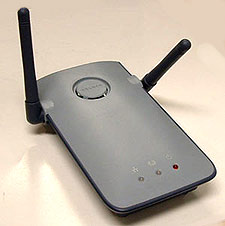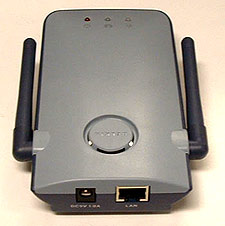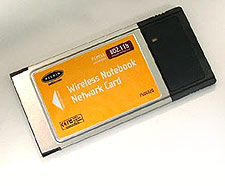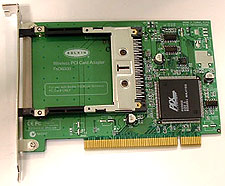Belkin Wireless 802.11b Networking Review
If Ethernet moving into the home was the first big revolution in networking, Wireless LAN or IEEE 802.11b, is slated to be the next. With a range of just over 300 feet indoors at 11Mbps, a wireless network enables many computers to communicate without the need for wires. That saves a lot of time and money not having to run CAT 5 cable everywhere. Data is sent over the radio waves at a frequency of between 2400~2483.5 MHz using Direct Sequence Spread Spectrum (DSSS) technology,
and so a few security measures need to be taken to safeguard yourself.
It sounds incredibly complicated but can really be set up an running in a matter of minutes. The few
limiting factors to a wireless network are first and foremost range,
how strong a signal the computer is receiving and what kind of interference may be present. The second is security, and the realization that unlike CAT 5 cable, you will need to take precautions to prevent unexpected visitors from breaching your LAN security. More on that in a bit.
The bits and pieces of a
WAN
Belkin offer three essential components to make the
move to a wireless network easy. The first and most important component is the
Access Point. Like its name suggests the Access Point (AP) is an internetworking
device that seamlessly bridges the gap between wired and wireless networks. It
is sometimes also referred to as a WAP - wireless access point.
|

|

|
| The Belkin F5D6130 WAP is a 50mW 802.11b compliant dual
antenna device which has one 10BaseT RJ45 Ethernet port. An external
adapter powers the AP which is small in size and very simple to
connect. Three indicator LED's on the front of the unit show Ethernet
activity, wireless TX/RX activity, and power. Both antennas are mounted on
swivel points and can be adjusted depending on how the F5D6130 is mounted
(wall mounts on rear). During our tests the Belkin AP reached an operating
temp of 44 degrees Celsius. |
Next up in order to actually connect to a WAN
(wireless area network) we need a antenna which translates those wireless
signals into little bits of data the computer understands. The two devices which
we are looking at today go hand in hand for desktop computers. A PCMCIA wireless
network card is what actually receives the signals and does the translation from
high frequency radio waves to one's and zero's, but it is the PCI adaptor card
which allows the wireless NIC to plug into a standard desktop computer.
|

|

|
| The Belkin F5D6020
wireless notebook network card is a PCMCIA based 802.11b adaptor. The black portion of the card houses the small internal antenna which sticks out an inch or so once the card is installed. There is no external antenna extension jack however. This PCMCIA card can either be inserted
into a standard lap top to give it wireless network capabilities, or used in conjunction with Belkin's F5D6000 PCI adaptor card. The PCI card basically bridges the gap between the network adaptor's PCMCIA interface and the standard 32-bit PCI interface of desktop computers. |
Naturally, if you are just using a laptop you can forgo the PCI adaptor card, but the nice thing is that with this arrangement, you
only need to spend money on one multi-use wireless adaptor card.

